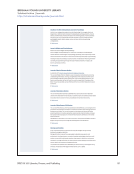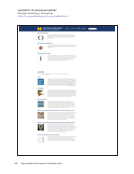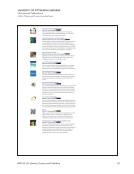53 SPEC Kit 357: Libraries, Presses, and Publishing
Publicity about our software capabilities and available expertise on website and outreach by liaison
librarians to academic departments.
The authors are usually internal curators.
The Digital Publishing Librarian is embedded with the library liaison program and is a member
of several library committees. This enables the librarian to leverage the university connections of
library colleagues to generate ideas for marketing and direct appeals. The librarian frequently attends
university-wide symposiums to network with faculty, administrators, and research support staff. He
presents and demos publishing services at departmental meetings whenever possible.
The library’s outreach efforts (email, participation in department or college events, etc.) focus primarily
on promoting the library’s publishing services rather than marketing specific journal titles.
The Scholarly Communication Librarian in conjunction with subject specialists helps to disseminate
information about the repository to individual departments.
The Scholars Archive (IR) administrator and subject librarians regularly reach out to departments and
faculty to solicit their publications. Personal contact and department meetings are used.
This activity is left to the editors of the journals.
We advertise EBM services through promotional emails to campus, workshops, etc.
We do outreach within the institution (in collaboration with our scholarly communication librarian,
subject specialists) to encourage participation in our institutional repository, which we consider a form
of publishing. The scholarly collectives with whom we work do their own outreach and networking to
encourage participation in their communities.
We have marketing materials for various library services, open access publishing among them.
These materials are distributed to new faculty and students, primarily in the fall, by our academic
liaison librarians.
We work with liaison librarians to get the word out. We also hold workshops and presentations
specifically for faculty on open access and related topics.
We work with the university’s history of science department and relevant history of science
organizations to solicit content for EOS.
Web page promotion, open access Open Data Steering Committee outreach activities, YFile newsletter,
word of mouth, presentations to campus stakeholders, liaison outreach
Word of mouth
Word of mouth is primarily used. Library liaisons interact with potential authors through their
liaison activities.
Word of mouth, speaking at conferences, open access week events and activities, faculty and student
outreach within academic departments, web content promoting of services, social media (twitter
and Facebook)
33. Please briefly describe the outreach methods the institutional press uses to enlist/engage authors
in publishing activities. N=3
Primarily through personal contact.
Provost and dean level engagement tour, word of mouth, library communications, collaboration with
Digital Scholarship Center, eLearning
Word of mouth
Publicity about our software capabilities and available expertise on website and outreach by liaison
librarians to academic departments.
The authors are usually internal curators.
The Digital Publishing Librarian is embedded with the library liaison program and is a member
of several library committees. This enables the librarian to leverage the university connections of
library colleagues to generate ideas for marketing and direct appeals. The librarian frequently attends
university-wide symposiums to network with faculty, administrators, and research support staff. He
presents and demos publishing services at departmental meetings whenever possible.
The library’s outreach efforts (email, participation in department or college events, etc.) focus primarily
on promoting the library’s publishing services rather than marketing specific journal titles.
The Scholarly Communication Librarian in conjunction with subject specialists helps to disseminate
information about the repository to individual departments.
The Scholars Archive (IR) administrator and subject librarians regularly reach out to departments and
faculty to solicit their publications. Personal contact and department meetings are used.
This activity is left to the editors of the journals.
We advertise EBM services through promotional emails to campus, workshops, etc.
We do outreach within the institution (in collaboration with our scholarly communication librarian,
subject specialists) to encourage participation in our institutional repository, which we consider a form
of publishing. The scholarly collectives with whom we work do their own outreach and networking to
encourage participation in their communities.
We have marketing materials for various library services, open access publishing among them.
These materials are distributed to new faculty and students, primarily in the fall, by our academic
liaison librarians.
We work with liaison librarians to get the word out. We also hold workshops and presentations
specifically for faculty on open access and related topics.
We work with the university’s history of science department and relevant history of science
organizations to solicit content for EOS.
Web page promotion, open access Open Data Steering Committee outreach activities, YFile newsletter,
word of mouth, presentations to campus stakeholders, liaison outreach
Word of mouth
Word of mouth is primarily used. Library liaisons interact with potential authors through their
liaison activities.
Word of mouth, speaking at conferences, open access week events and activities, faculty and student
outreach within academic departments, web content promoting of services, social media (twitter
and Facebook)
33. Please briefly describe the outreach methods the institutional press uses to enlist/engage authors
in publishing activities. N=3
Primarily through personal contact.
Provost and dean level engagement tour, word of mouth, library communications, collaboration with
Digital Scholarship Center, eLearning
Word of mouth



















































































































































































